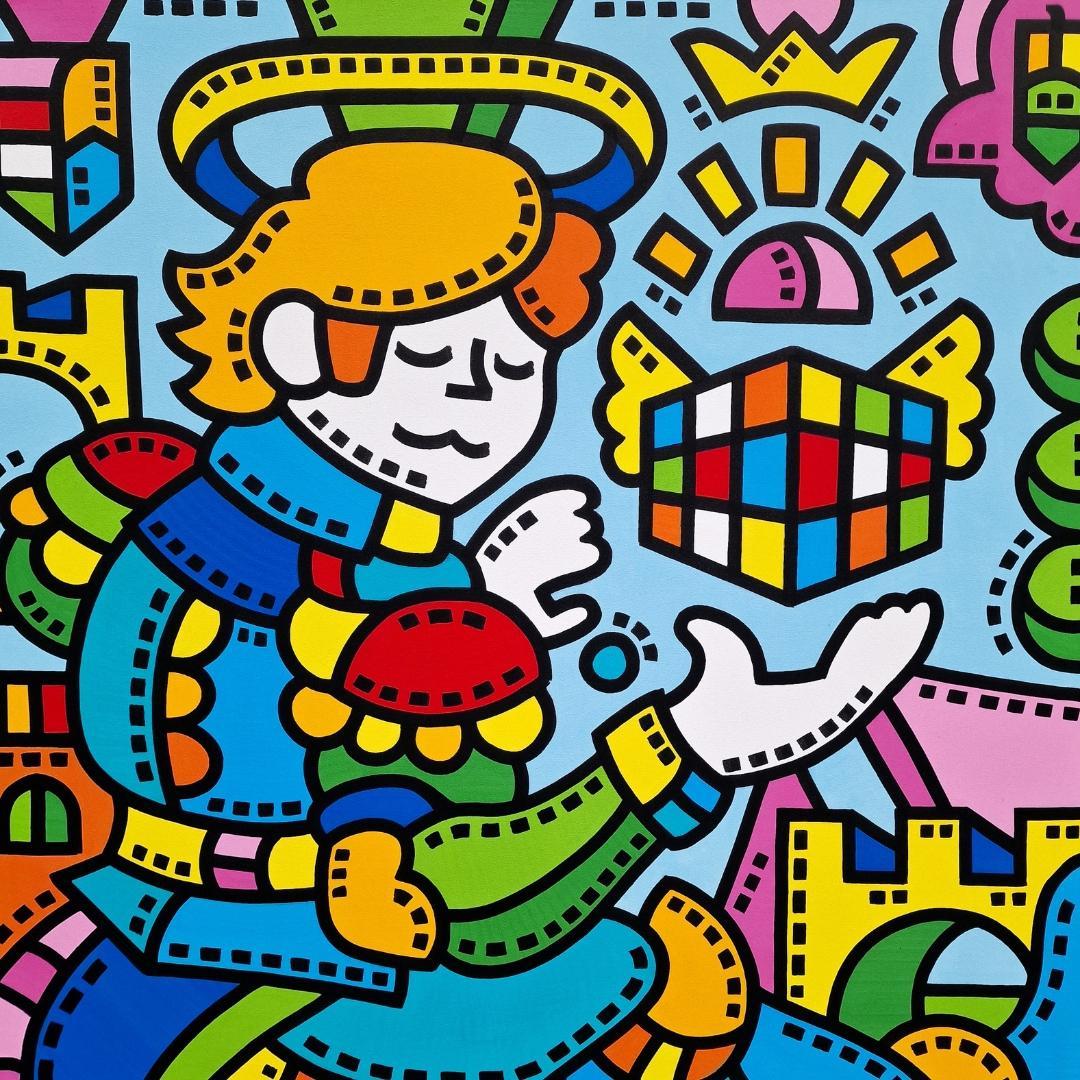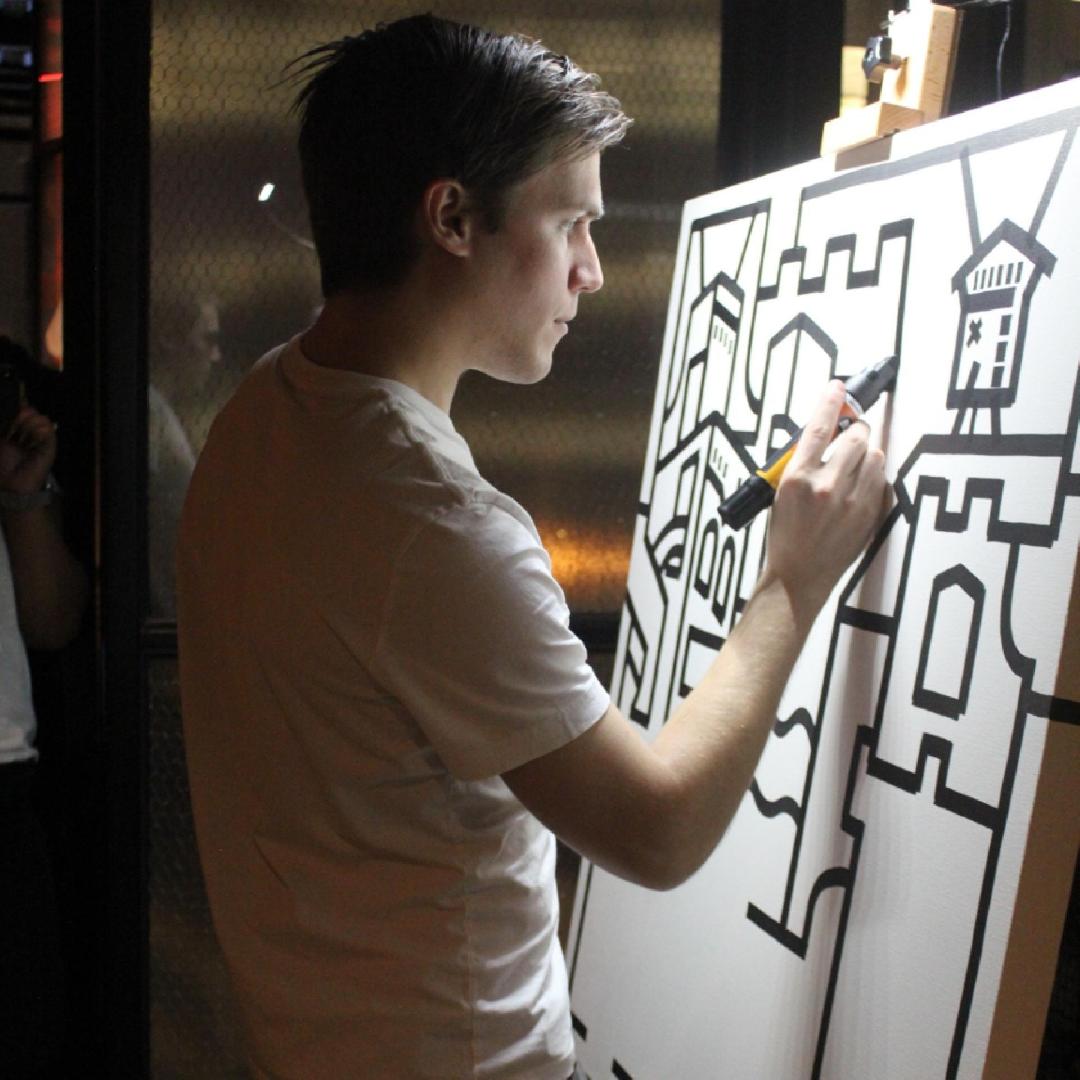In the framework of an exciting interactive community workshop on April 9 at Central Park, Hungarian-American visual artist Rob Anderson created a captivating artwork featuring the Rubik’s Cube, celebrating the 50th anniversary of its innovation. In the context of this uplifting event the Liszt Institute New York interviewed the young artist and asked him about his career, his inspirations and his Hungarian heritage.
LINY: How did you first become interested in art and what solidified the idea of being an artist?
Rob Anderson: The wonderful thing is, I’m still becoming interested in art! I can highlight some of the core childhood memories that started to snowball my fascination with creativity and art. In my bookcase, among the many colorful kids books- some of them in Hungarian- was a black and white cartoon strip called Calvin and Hobbes by Bill Watterson. Imaginative, hilarious, philosophically deep, I loved how much story and feeling could be told through such small yet beautifully drawn panels. I was obsessed with Lego, building skyscrapers and spaceships. I played SimCity and when I was in school I’d fill notebooks with city plan drawings. In my teens, I started to love music and picked up the bass guitar for the first time when I was 14. I thought music would be my career at one point. Then, around 2009, I was riding the subway and noticed something new. Everyone was staring at their new smartphones. I had an idea that moment that I would carry a sketchbook with me at all times and try to get better at drawing whenever I had free time. 15 years later I still carry a sketchbook. I had no idea that it would lead to a career in murals, arts education, and community art events, and I feel like this is just the beginning.
LINY: Where do you draw inspiration from in your artwork and how did you create your unique style?
RA: There are days when I feel like I can create all day, and some where a paintbrush feels like the heaviest object in the world. I still push myself to create. Process is so important, all the good stuff comes from it. If you want something, you have to start working, the rest will fall into place. For every “good” drawing I share, are dozens of experiments and failures. But I still treat them with love. All those bad drawings and mistakes bring me steps closer to new breakthroughs. My style is a culmination of the repeated aesthetic choices I’ve made, and within it is a visual, symbolic vocabulary that contains my love for aerospace, ancient history, street art, and architecture, just to name a few.

Rob Anderson's artwork celebrating the 50th anniversary of the innovation of the Rubik's Cube
LINY: Is there a strong connection to music in your artworks?
RA: Music was my first love. Making music is being playful with vibration over organized time. That is SO cool that humans play music. It brings everyone into the present moment. In high school I played electric and upright bass in jazz band and orchestra, and over the summers my friends and I would take college courses in Jazz improvisation and performance. The philosophies of leading a band, improvising with others, and performing for an audience have greatly informed my artwork and present-day community art event motivation. I look at lines like movement, colors like harmonizations, and dashes like rhythms. I create my artworks for events in a way that welcomes people to play in the orchestra of the painting. By looking at my work like a band, I get people to joyfully interact with each other and the larger composition before them.
LINY: What is your connection to Hungary and what impact did it have on your life as an artist?
RA: I grew up in a Hungarian-American household in Queens, New York. My sister and I spoke fluently as children. As school began, everyone switched to speaking English. I’m grateful that our grandparents kept the language in our ears. We visited Hungary only a few times, then stopped going all together. In some sense I feel like we became disconnected from our roots. Then, in 2015 my mother, sister, and I returned to visit family once again. This time I was 26 years old and developing my passion for art. Hungary completely heightened my senses and appreciation for our history and culture, and I was overcome with inspiration and happiness. We visited Pécs, Szentendre, Budapest, and walked through museums, temples, castles, and beautiful landscapes rich with stories and a unique past. I sketched everywhere. Something in this time period marked a stylistic shift for me. Being able to look up at the massive Csontváry canvases, in awe of the details adorning Parliament, and witnessing the ceaseless Danube all contributed to my wanting to make bigger, historically significant, and community invigorating types of artwork. When I got back to the states, all the things I wished for in Hungary came true with a lot of hard, determined work. I wouldn’t return until 2022. A wonderful student organization from Nyíregyháza called Tekerd contacted me on Instagram and asked me to provide a design for their students to transform into a giant Lego mosaic for their exhibition in Budapest. They didn’t even realize I was Hungarian. I took this as a sign that I should go back, so I offered to do the design and visit their students to make murals and give art lessons. A few weeks later, I was on a plane without a return ticket. I stayed in Budapest for a month. I reconnected with family. I taught myself to speak Hungarian. I made enormous new work inspired by my travels. It became abundantly clear once again how important it is for me to maintain a connection to Hungary and family. Between 2022 and 2024 I’ve been back 4 times. Now, I aspire to live there permanently. New York City showed me how to be an artist, but Hungary helped give it meaning.

